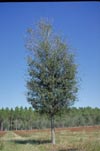Home >
Quercus virginiana Cathedral Oak™, Cathedral Oak™
Cathedral Oak™ Live Oak parent tree was 22 feet tall by 9 feet wide when the plant patent was applied for in the late 1990's. The tree had one dominant trunk with small diameter branches after a competing leader was subordinated. This upright growth habit may serve it well in urban landscapes and make it well adapted for street tree planting. Like the other cultivar live oaks, all individuals look pretty much alike but the ultimate shape of the tree is not known-probably will be oval to rounded.
Best growth is made in moist, acid soil, sand, loam or clay, but the tree is amazingly adapted to drought. It also tolerates alkaline soil well. Construction-impacted trees take a long time to die, giving Live Oak a reputation for being a tough tree. Once established, Live Oak will thrive in almost any location and has very good wind resistance. Live Oak is a tough, enduring tree that will respond with vigorous growth to plentiful moisture on well-drained soil. Trees compartmentalize decay very well but they are not immune to decay. Trees can live several hundred years but are typically younger than they look. Live oak is capable of growing about one inch each year for the first few decades after planting. This cultivar might not spread as wide as the species; no one really knows yet.
Like other Oaks, care must be taken to develop a strong branch structure early in the life of the tree. This tree often develops included bark in the crotches of main branches making the tree susceptible to breakage. Quercus fusiformis is native to central and southern Texas, is perhaps more adapted to Texas than Quercus virginiana but nursery operators do not normally differentiate among these. Q. geminata (Sand Live Oak) is more salt tolerant than Live oak. Live oak is the state tree of Georgia.
Live oak is over-planted in Florida and in other communities in the deep south. This same type of situation was responsible for disasters in other parts of the country in the past. For example, American elm was over-planted in the late part of the 19th century and the early part of the 20th century in many communities; in the decades following the appearance of Dutch elm disease, nearly all elms in most communities were killed. There are many other oaks that could be planted in place of live oak. They include Quercus germinata (native), acuta, acutissima, agrifolia (native to California), alba (native), austrina (native), falcata and varieties (native), fusiformis (native), geminata (native), georgiana (native), incana (native), lyrata (native), marilandica (native), michauxii (native), muehlenbergii (native), nuttallii (native), phellos (native), shumardii (native), suber, texana (native), velutina (native).
Oak
wood is considered ring porous to semi-ring porous. Plant serves as host
for White M. Hairstreak (Parrhasius m-album) butterfly larvae and
the brown duskywing butterfly (Erynnis horatius).



